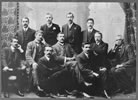Nationalised
In 1936 the new Labour government nationalised the Reserve Bank. Labour also amended the Reserve Bank Act to give the minister of finance the power to direct the central bank’s policy. Though the government did not interfere on everyday matters, it did at times instruct the Reserve Bank to extend credit to the public sector, especially in aid of the state housing programme and the dairy industry. Growing state involvement in central bank policy-making was a global phenomenon in the mid-20th century. Monetary economists and historians often lament the disappearance of central bank independence in the 1930s and 1940s, but the relationship between central banks and governments was understood at the time as a partnership.
Home sweet home
Returning from a stint overseas in 1982, assistant governor Lindsay Knight compared the Reserve Bank to ‘an old and comfortable slipper … Sitting down again in the same old comfortable office with the same old tediously tasteful decorations, facing again the gracefully presented morning tea tray with those fresh home-made buttered scones that have always been the envy of visiting Treasury officers, one knows that this is home indeed.’1
Tightly regulated economy
From 1938 until 1984 the New Zealand economy was tightly regulated, with the aim of ensuring full employment. The key was to insulate New Zealand from economic shocks, whether transmitted from overseas or originating in the domestic financial sector. Within this framework, the function of the Reserve Bank was to manage a host of controls over foreign transactions, bank lending, interest rates and bank reserves. There were also restrictions over the sort of business each sort of financial institution could accept. For example trading banks were prevented from competing directly with savings banks. Denied the opportunity to compete aggressively for new business, the banking industry became inefficient.
Instability, 1970s
In the mid-1970s the New Zealand economy entered a period of instability. Two oil crises, rising inflation, balance-of-payments difficulties, erratic economic growth and the end of full employment all taxed the skills of policy-makers. Some younger Reserve Bank officials were already advocating less regulation and the adoption of a more flexible interest-rate policy. By the 1970s many other central banks were trying to influence spending by adjusting interest rates, and some were beginning to set targets for the money supply.
Starting in 1976, Robert Muldoon, the prime minister, experimented with flexible interest rates, but in 1981–82, after the second oil shock, he intensified all controls over the financial sector and introduced a wage and price freeze to halt inflation. Although the Reserve Bank and Treasury warned against these policies, they had lost the confidence of Muldoon, who ignored unpalatable advice. The early 1980s was a period of central bank impotence in New Zealand. By contrast, the Federal Reserve in the United States was then at its most decisive and effective.
Muldoon and the central bankers
The later years of the 1975–84 Muldoon-led National government were difficult for central bankers. Ray White, Reserve Bank governor since 1977, declined a second term in 1982 because he could not work with Muldoon. His successor, Dick Wilks, resigned early in 1984, allegedly at Muldoon’s prompting. Muldoon then appointed Spencer Russell, expecting him to be compliant, but Russell, formerly of the National Bank, stood up to Muldoon’s bullying during the 1984 exchange-rate crisis.
Reforms, 1980s
Muldoon’s government was defeated in 1984. The election campaign was accompanied by a run on the currency, which led to a post-election devaluation. Muldoon charged the Reserve Bank and Treasury with ineptness in the management of New Zealand’s foreign exchange reserves and in the overall conduct of policy during this episode.
To the surprise of most observers, the incoming Labour government scrapped nearly all of the controls over the banking industry and over the balance of payments accumulated since 1938. The exchange rate was floated in 1985. Monetary policy was now implemented through the market. Inflation rose strongly for a while after the end of the freeze, but interest rates were encouraged to rise to levels at which spending was dampened, and inflation was brought under control. The soaring New Zealand dollar reinforced the downward momentum of inflation. Roger Douglas, the minister of finance, was supportive of the Reserve Bank, and a partnership between the government and the central bank was restored. Under existing legislation, however, Douglas was still the boss. The central bank was not yet independent.




